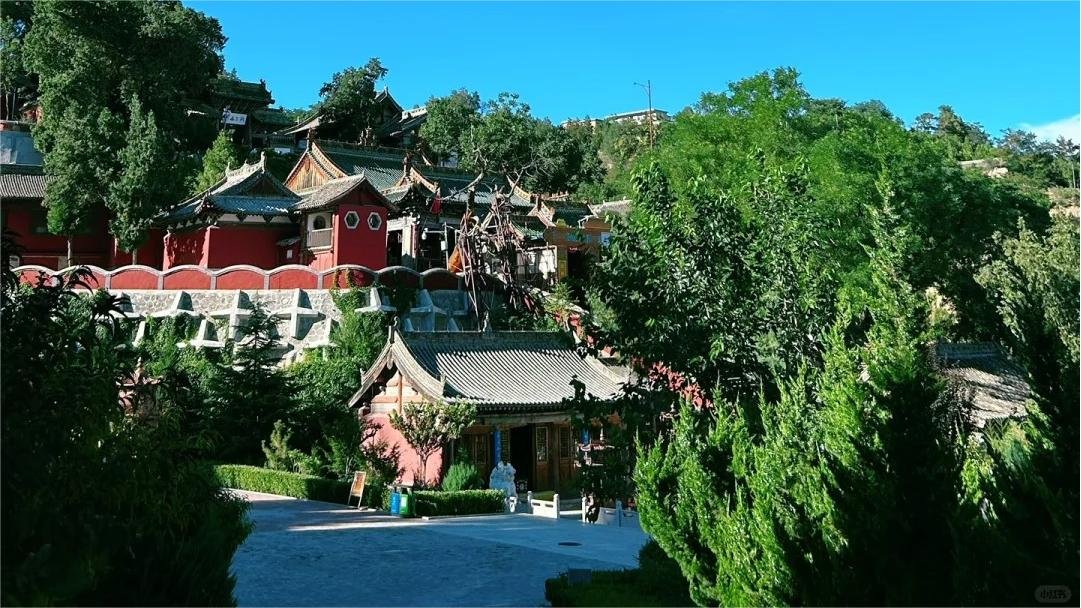Yuquan Temple (玉泉观), also known as Chongning Temple, is nestled at the foot of Tianjing Mountain in the northern part of Tianshui City, Gansu Province, China, at an elevation of 1230 meters. Its name originates from the crystalline and sweet-scented Yuquan Spring, described poetically during its establishment by Liang Gongbi, a Yuan Dynasty official, who penned the phrase “Within the temple in the northern suburb, there is a jade spring (yuquan) flowing out from the mountain” (山寺北郊,名山玉泉). Locally referred to as Chengbei Temple, this site dates back to the third year of Yuan’s Dade (1299 AD), and many of its present buildings were reconstructed during the Ming and Qing dynasties. Today, it stands as one of China’s prominent Taoist temples.
Covering an area of over 90,000 square meters, Yuquan Temple features the “Yuquan Immortal Cave,” one of Qin Prefecture’s eight scenic spots, a legendary burial site of the three immortals, Lu, Liang, and Ma. During the first lunar month of each year, the temple hosts a bustling temple fair, known locally as “Chaogan (朝观),” drawing visitors to enjoy the early spring festivities.
The temple houses a collection of 47 stone tablets, 11 stone steles, and 34 brick carvings from the Yuan, Ming, and Qing dynasties. Among them, the Yuan Dynasty’s Daoist Flow Four-Sided Stele is highly esteemed for its clear inscriptions and comprehensive historical records, recognized as a national treasure by archaeologists. Additionally, a rare stone stele featuring calligraphy by the Yuan Dynasty’s eminent calligrapher Zhao Mengfu is also preserved within the temple grounds.
Table of Contents
- Basic Information
- Location and Transportation
- Highlights of Yuquan Temple
- Other Attractions in Tianshui Urban Area
Basic Information
| Estimated Length of Tour | 1 – 2 hours |
| Ticket Price | 20 RMB |
| Opening Hours | 8.00 – 18.00 |
| Telephone Number | 0086-0938-8213957 |
Location and Transportation
Yuquan Temple is located at the foot of Tianjing Mountain in the northern part Tianshui City, Gansu Province, China. Its precise address is 69 Yuquan Road, Qinzhou District. To get there, you can take bus 7, 14, 17, 24, 26 Inner Loop Line, 26 Outer Loop Line, 83, or 96 and get off at Yuquan Temple Stop (玉泉观站).
Highlights of Yuquan Temple
Yuhuang Pavilion (玉皇阁)

Yuhuang Pavilion stands proudly on a 1.45-meter-high platform, oriented north to south. Originally built during the Yuan Dynasty, it has undergone three major restorations during the Qing Dynasty, in the years 1809, 1845, and 1903. The pavilion’s dimensions are 12.2 meters in width and 6.05 meters in depth, featuring a classic Xieshan-style roof adorned with green tiles and dragon finials.
The pavilion’s eaves are supported by four columns, each showcasing intricate carvings. The outer eaves feature a decorative design of dragons and flowers, while the inner eaves display a detailed carving of two dragons playing with a pearl. The architectural elements, including the large horizontal plaque and the exquisite carvings, reflect the fine craftsmanship of the Ming Dynasty era.
Yuhuang Hall (玉皇殿)

Located directly behind the Yuhuang Pavilion, Yuhuang Hall faces south and was originally constructed during the Yuan Dynasty in 1289. It was later renovated in 1637 during the Ming Dynasty and is notable for its well-preserved Ming Dynasty architecture.
The hall measures 11.7 meters in width and approximately 10.5 meters in height. It features a single-eaved Xieshan roof with nine ridges, covered with green glazed tiles. The roof is adorned with decorative pavilions at the central ridge and embellished with dragon and lion motifs on the sides.
Inside, Yuhuang Hall boasts a unique wooden beam structure with a traditional Cheshang exposed ceiling. The seven-beam construction uses a combination of Xieshan and Cai Bu Jin techniques, showcasing the architectural sophistication of the Ming period.
Jade Spring (玉泉)

Jade Spring (Yuquan), located beneath the Cangsheng Hall, is one of the most enchanting features of Yuquan Temple. Originally established during the Yuan Dynasty in 1291, the spring was renovated in 1302 and again during the Qing Dynasty’s Qianlong era in 1776. The spring’s serene waters were believed to have healing properties. The original pavilion over the spring was destroyed during the Cultural Revolution but was restored in 1981. This pavilion offers visitors a picturesque view surrounded by ancient trees and lush greenery. In May 2000, the Sacred Water Source Company invested in further restoring the spring, digging to a depth of 17.5 meters and reinforcing it with a cement lining to maintain a stable water level.
Ancient Trees (古树)

Yuquan Temple is also famous for its collection of ancient trees, with over 50 trees documented as of 2006. Among these, more than ten are over 1,000 years old, and 23 are over 300 years old. The most notable species include the Chinese Arborvitae, Sophora japonica, and Honey Locust trees. The temple boasts the highest density and average age of ancient trees in Tianshui City.
One particularly revered tree is the “Braid Cypress” located on the cliffside south of the Immortal Cave. This ancient cypress is celebrated as a unique natural wonder and a symbol of the temple’s enduring heritage.






